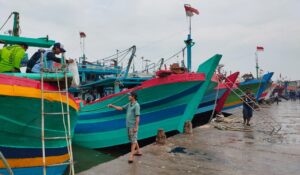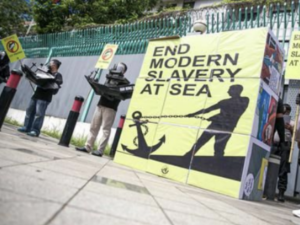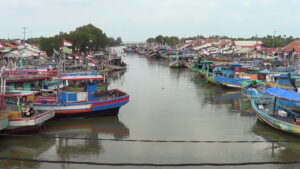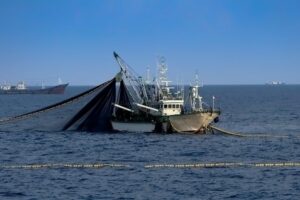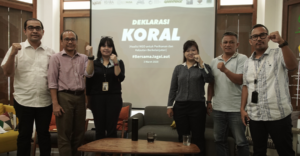
The National Fish Barn Project (LIN) is nothing new to Indonesians. The project, which was first planned under the leadership of President Susilo Bambang Yudhoyono in 2010, is expected to make Maluku the new marine economic center in Eastern Indonesia. Maluku is the center of this project since it houses a large percentage of the National Fish Resources (SDI). Out of the national 12.5 million tons SDI per year, Maluku’s SDI across three Fishery Management Areas (FMA) is 4.6 million tons per year.
In August 2020, the Coordinating Ministry for Maritime Affairs and Investment (Kemenkomarves), the State Secretariat, and the Ministry of Marine Affairs and Fisheries (KKP), went to Maluku Province to directly observe the area which will later become the location for the construction of the Integrated Port, which will be integral to LIN in Maluku. At that time, Edhy Prabowo said that the development of LIN in Maluku would be a milestone in the marine and fisheries sector because Maluku is the right province in terms of fisheries potential. The province is made of cities that are reliable in processing fishery products, for example, Tual City, Dobo and Benjina (Aru Islands Regency), as well as Ambon, which has been known as a very reliable fish producer. The four locations are leaders in developing fishery products in the Maluku region.
During the leadership of the new Minister of Marine Affairs and Fisheries, Sakti Wahyu Trenggono, LIN was again a major program under KKP.
The construction of LIN in Maluku is scheduled to start in 2022 and is targeted to be operational in 2023. By then, ports and other supporting infrastructures such as fishing port offices, docks, cold storage, ice factories, laboratory buildings, culinary centers, and of course places and production, processing, and marketing lines that are effective and efficient are expected to be ready as well, in accordance with the direction of President Joko Widodo.
There will be three FMAs that will be affected by this project: FMA 714 Banda Sea, FMA 715 Seram Sea, and FMA 718 Arafura Sea. It is estimated that fishery production that can be produced from the capture fisheries and aquaculture sub-sectors can reach 750,000 tons per year and absorb more than 30,000 workers. However, a good vision must be followed by a transparent, precise, and efficient mission and implementation.
There are several things that need to be considered and solutions to be sought from the government regarding this national project. The first is the selection of fisheries management areas. The three areas have fishery potential which is dominated by marine commodities such as:
1. Small pelagic fish; kite fish, selar fish, bentong fish, mackerel banyar/bloating men, siro fish, and tembang fish.
2. Large pelagic fish; tuna and mackerel
3. Demersal fish; red snapper, kuwe fish, white snapper, catfish, swanggi fish, white pomfret, kuniran fish, and layur fish.
4. Reef fish; yellowtail fish and grouper
5. Penaeid shrimp;
6. Lobster;
7. Crab;
8. Squid.
Referring to the Decree of the Minister of Marine Affairs and Fisheries No. 50 of 2017 concerning Potential Estimation, Permitted Catch Amount, and Level of Utilization of Fish Resources in the Fisheries Management Area of the Republic of Indonesia, level of resource utilization Fish resources in FMA 715 are classified as fully exploited (2 commodities with moderate status, 4 commodities fully-exploited and 3 commodities over-exploited). Meanwhile, for FMA 714, the utilization status is dominated by fully and over-exploited (2 commodities with moderate status, 4 fully-exploited commodities, and 3 over-exploited commodities). Lastly, FMA 718 has a fully and over-exploited utilization status (7 commodities with fully exploited status and 2 commodities with over-exploited status).
This of course must be a concern from all parties because the Fish Barn Project will open up opportunities for exploitation of fishery resources in the waters of Maluku and North Maluku. This is especially dangerous if the allotment of profits will only benefit large-scale fishery businesses and open up unfair competition gaps for small fishers in the Maluku and North Maluku regions. Maritime and Fisheries Economics observer, Suhana, assessed that if the Fish Barn Project is used as a source of welfare for local fishers, then its development is very much needed. However, it is opened only for the purpose of attracting foreign investment, it will actually reduce local welfare. Based on data from BKPM, foreign investment in the fisheries sector in the first semester of 2020 was dominated by China at 70.55 percent, followed by Japan at 11.22 percent. About 70 percent of foreign investments are mostly planted in the Maluku and Papua regions.
The Secretary-General of the People’s Coalition for Fisheries Justice (KIARA), Susan Herawati, shared the same concern. She said that if the Fish Barn Project was intended for large-scale fishery industrialization, it would marginalize traditional fishers or small-scale fishers in Maluku Province (163,441 people) and in North Maluku (34,944 people).
Therefore, there are several things that need to be done by the government to ensure the welfare of coastal communities, especially small-scale fishers. First, strengthening the empowerment of fishers from the grassroots level. The Fish Barn Project should not only focus on regional division based on the potential of fish resources, but also the empowerment of fishers by empowering each village based on fishery commodities. If this is the case, coastal communities and small-scale fishers can get additional benefits from commodity-based businesses in fisheries areas that can be tangible aquaculture or processing and selling quality marine products that meet the standards.
Second, there should be data collection, area and number restrictions, as well as arrangements for fishing methods that are allowed in the area. This is important to do, considering a large number of small-scale fishers with vessels under 30 GT operating in Maluku and North Maluku. These small-scale fishers, with limited infrastructure, also have a limited cruising range. If the already limited area is shared with large-scale ships, it will certainly cause socio-economic conflicts that are detrimental to them. The division and delimitation of this area must also pay attention to the sector or area of biological development and conservation so that there are still areas intended for marine biological resources to breed without being exposed to the risk of being caught by fishers. The prohibition of destructive and exploitative fishing gear (API) and restrictions on the number of catches are also mandatory, especially because the utilization status of the three FMAs listed is threatened with exploitation. On the other hand, supervision and sanctions for violations committed must also be enforced. The central government and local governments are obliged to coordinate with BAKAMLA and the authorities in securing the waters in the area.
Third, the government must prepare a number of plans and actions that focus on returning to the sea to ensure a healthy fishery stock in the future. The number of fish that is returned to the sea must be more than what is taken because the number of fish released to breed in the sea has a fairly low survival rate. For example, of all lobster seeds that are released into the wild, only about 0.01 percent can grow perfectly.
The Fish Barn Project is expected to be able to accommodate the welfare and prosperity of coastal communities by paying attention to the health of natural and biological resources in the waters of Maluku and North Maluku. Article 33 paragraph 3 of the 1945 Constitution states that “Earth, water and the natural resources contained therein are controlled by the state and used for the greatest prosperity of the people.” This confirms that the state is obliged to regulate the utilization of natural resource wealth (SDI) including fishery potential for the greatest prosperity of the people. The utilization of natural resources must be distributed fairly for the prosperity and welfare of the Indonesian people in the territory of the country, and the government is obliged to guarantee prosperity and welfare not only felt in the short term but also must look to the future so that the next generation can also enjoy Indonesia’s natural resources.
